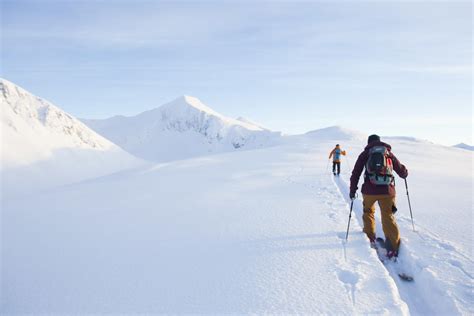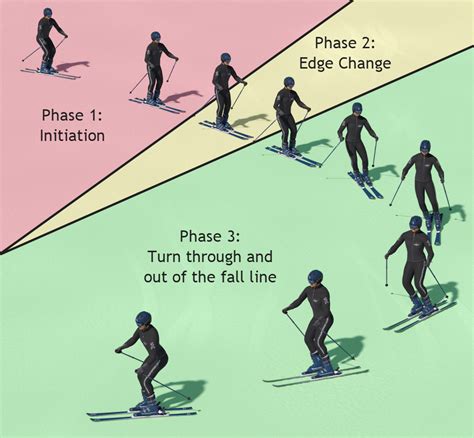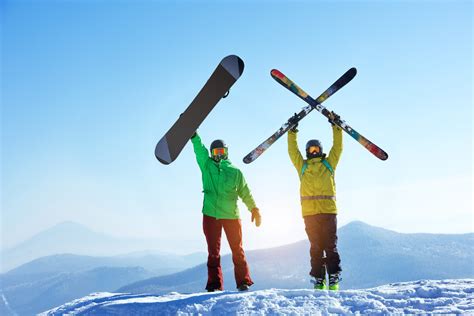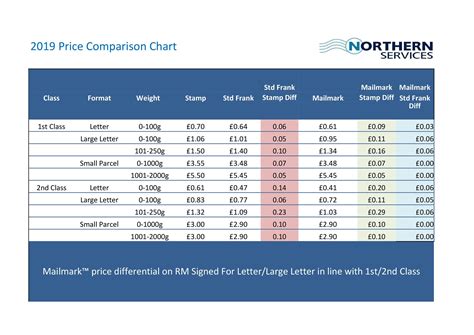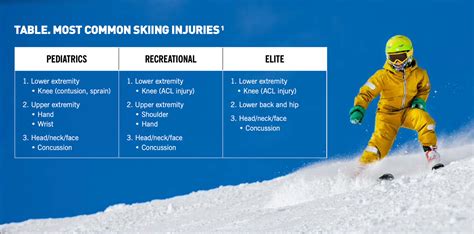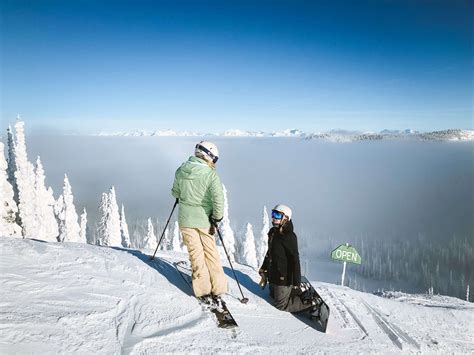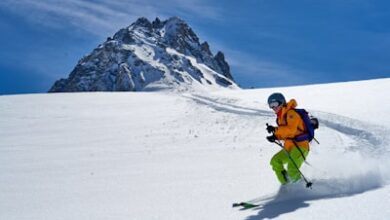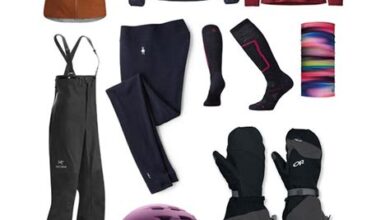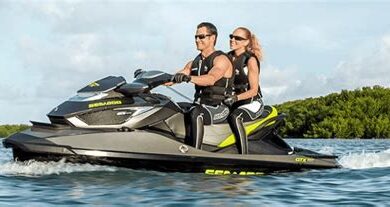Is Skiing Or Snowboarding Easier?⏬
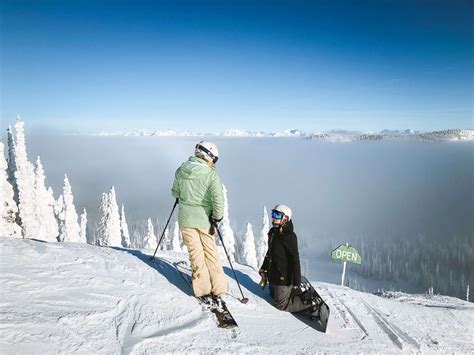
Discover whether skiing or snowboarding is easier to learn, understand the costs, physical demands, and injury risks for both, and make your choice.When the allure of pristine, powdery slopes calls your name, a critical choice awaits: will you carve your path with skis or a snowboard strapped to your feet? For many winter sports enthusiasts and novices alike, the question of whether skiing or snowboarding is easier remains as slippery and elusive as the icy trails themselves. In this blog post, we will glide through an introduction to both sports, compare their learning curves, examine the physical demands each places on the enthusiast, scrutinize the cost and equipment needed for both, evaluate the injury risks involved, and finally, help you arrive at a decision on whether to ski or snowboard. Whether you’re looking to embark on your first adventurous descent or simply aiming to switch disciplines, this guide will help you navigate the frosty world of winter sports with confidence and ease. So, fasten your goggles and let’s explore the slopes of the skiing versus snowboarding debate.
Introduction to Skiing and Snowboarding
When the winter season blankets the mountains in soft, powdery snow, adventure enthusiasts and holiday goers alike are often drawn to the exhilarating world of skiing and snowboarding. Both sports offer a unique way to experience the icy allure of snow-covered peaks, but the choice between strapping on skis or a snowboard can influence your experience on the slopes. In this introduction, we delve into the fundamentals of skiing and snowboarding, highlighting the distinctions and intrinsic appeals of each activity.
Skiing, characterized by its use of two narrow planks, has a long and storied tradition, tracing back its roots to ancient times when it was a vital means of transportation in snowy regions. Over the years, skiing has evolved into a diverse sport, with styles ranging from alpine to cross-country. The basic stance in skiing involves facing forward with a ski on each foot, offering a natural balance and the ability to traverse a variety of terrain with relative ease.
On the flip side, snowboarding is a more recent invention, growing in popularity since the 1960s as a sport inspired by surfing and skateboarding. It involves descending the slopes with both feet attached to a single, wide board, allowing for fluid, carving turns. Snowboarders typically stand side-on to the direction of travel, leading to a distinctly different approach to navigating the mountain compared to skiers.
For those interested in either sport, the choice might depend on various factors such as personal preference, coordination, and physical fitness. It is important to consider, especially for beginners, that each activity comes with its own set of learning curves. To offer a clearer perspective on what to expect, let’s compare the two beneath in terms of their physical requirements, equipment and cost, and potential injury risks.
- Physical Requirements: Skiing generally requires strong legs and knees to manage the parallel stance and turns, while snowboarding demands good core strength and flexibility due to its lateral stance.
- Equipment and Cost Comparison: Both sports require specific gear such as boots, bindings, and proper attire, though the actual costs can vary depending on the brand and quality.
- Injury Risks: The nature of falls and collisions can differ between the two, with skiing often resulting in knee injuries and snowboarding in wrist and shoulder injuries.
In conclusion, whether you choose the time-honored paths of skiing or opt for the innovative thrills of snowboarding, both sides of the slope offer unique challenges and rewards. Understanding these nuances is the first step in making an informed decision on which sport to pursue. Stay tuned as we explore each of the subheadings in detail in subsequent sections, providing you with a comprehensive understanding aiding towards making your choice between skiing or snowboarding.
Learning Curves: Skiing Vs. Snowboarding
Embarking on a wintery adventure, many newcomers to alpine sports ponder whether skiing or snowboarding presents a gentler learning curve. Indeed, the initial ease of learning and the time required to become proficient on the slopes can influence one’s decision on which sport to pursue.
For those taking their first steps onto the snow, skiing is often perceived as more straightforward due to the natural position of the legs and the ability to independently maneuver each ski. Beginners can achieve basic plough turns and stops with a few lessons, propelling their confidence and enabling them to navigate easier trails relatively quickly. The independent leg movement in skiing somewhat mimics a walking motion, which can be reassuring for novices.
Conversely, snowboarding involves learning to balance on a single board, which can lead to a steeper initial learning curve. Beginners may spend their first few days encountering more falls and challenges as they master the essentials of edge control and stance. However, once the fundamentals are understood, snowboarders can often make significant strides, progressing to more advanced techniques and terrains sooner than some beginner skiers.
It is important to note that individual experiences can vary greatly and are influenced by several factors such as physical fitness, coordination, and even psychological comfort with the sport’s mechanics. The following table contrasts the typical progression milestones for beginners in both skiing and snowboarding during their first season.
| Sport | Day 1-2 | Day 3-5 | 1 Month |
|---|---|---|---|
| Skiing | Learning the plough, stopping, basic turns | Linking turns, attempting green slopes | Comfortable on green, exploring easy blue slopes |
| Snowboarding | Finding balance, falling leaf technique | Basic turns, beginning to traverse slopes | Gaining confidence, exploring blue slopes |
In conclusion, skiing may offer a quicker initial grasp of the basics, enabling newcomers to experience the joy of gliding on snow sooner. Snowboarding, while potentially more challenging at the outset, can reward the perseverant with a rapid advancement in skill level post the initial hurdles. Ultimately, the decision of skiing vs. snowboarding should rest on personal preference, patience, and the allure of each sport’s unique characteristics.
Physical Requirements for Skiing and Snowboarding
When delving into the realm of winter sports such as skiing and snowboarding, many enthusiasts often ponder over the specific physical requirements needed for each activity. It is crucial to comprehend that both sports demand a unique set of physical capabilities, conditioning, and strength. For skiing, one must possess the ability to maintain a strong, stable stance while manipulating separate movements of each leg, necessitating significant leg strength and core stability. Meanwhile, snowboarding challenges individuals to control board motion with a symmetrical stance, which requires effective coordination and balance.
In the context of leg strength, skiers typically rely on their quadriceps and hamstrings to navigate the slopes, necessitating robust muscle endurance. Snowboarders, on the other hand, engage their ankles and calves more intensively, as these areas help in steering the board. Both athletes must also work on their core muscles to ensure proper form and prevent injuries. Additionally, it is imperative for those partaking in either sport to undergo a range of motion exercises that enhance flexibility, especially in the hips and lower back regions.
Furthermore, cardiovascular endurance plays an essential role in both skiing and snowboarding. Effective oxygen utilization and stamina can significantly impact a participant’s ability to perform repeated runs down the slopes without succumbing to excessive fatigue. Here, we observe a shared requirement, albeit the extent of cardiovascular training may vary depending on the intensity and duration of each sporting session.
To emphasize the physical demands of these sports, a comparison has been organized in the table below. This table exhibits the primary muscles utilized, the balance and coordination necessities, and cardio requirements side by side for skiing and snowboarding:
| Skiing | Snowboarding | |
|---|---|---|
| Main Muscles Used | Quadriceps, Hamstrings, Glutes, Inner/Outer Thighs, Core | Ankles, Calves, Core, Upper Body (for turns and tricks) |
| Balance & Coordination | Crucial for separate leg movements and maintaining a parallel stance | Key for board control and the symmetrical stance maneuvers |
| Cardiovascular Endurance | High demand for long runs and varied terrain | Essential for sustained energy on the slopes and trick execution |
Regardless of whether one opts for skiing or snowboarding, it is evident that both sports require a commitment to physical preparation. Beyond the thrill and exhilaration, participants must acknowledge the necessity of targeted training routines that cultivate the muscular strength, flexibility, and cardiovascular health imperative for peak performance and safety on the icy terrain.
Equipment and Cost Comparison
When considering the commencement of a snow-laden adventure, prospective enthusiasts often ponder the distinctions between skiing and snowboarding, particularly in terms of equipment required and the overarching cost implications. An in-depth comparison elucidates the variances that potential participants should factor into their decision-making process. The economic aspect of beginning either sport can be a decisive point for many, therefore a comprehensive analysis is imperative.
Embarking on the skiing journey necessitates the acquisition of skis, ski boots, bindings, poles, a helmet, goggles, and appropriate winter apparel, including a jacket and waterproof pants. On the other hand, snowboarding requires a snowboard, snowboard boots, bindings, a helmet, goggles, and similar winter attire. While the types of equipment differ, the need for high-quality, weather-appropriate gear remains a steadfast constant in both sports, ensuring comfort and safety on the slopes.
In an effort to delineate the cost distinctions, a categorized table may serve as a beneficial tool for visual comprehension:
| Item | Skiing | Snowboarding |
|---|---|---|
| Boards/Skis | High-end skis can run significantly higher in price compared to beginner models, often due to advanced technology and materials used. | While snowboards can also be pricey, there is a noticeable price range that allows for more flexibility in terms of budgeting. |
| Boots | Ski boots can be quite costly due to their sophisticated design and the need for a precise fit to ensure proper support. | Snowboard boots, while still requiring a good fit, generally come in at a lower cost and offer more versatility outside of the actual sport. |
| Bindings | The price of ski bindings can vary widely but they are an essential component that should not be overlooked for safety reasons. | Snowboard bindings also vary in price, but they tend to be less complex, potentially making them slightly more affordable. |
| Additional Gear | Ski poles add an extra cost for skiers, but they aid in balance and movement, especially for beginners. | Snowboarding does not require poles, which is one less piece of equipment to purchase and maintain. |
Moreover, when factoring in the prospective long-term participation in either skiing or snowboarding, it is essential to consider not only the initial purchase prices but also the ongoing maintenance costs, such as waxing and edge tuning for both skis and snowboards. These expenses manifest steadily over time and contribute to the total investment in one’s selected snow sport. Additionally, enthusiasts must contemplate whether purchasing equipment or opting for rental options aligns best with their financial means and level of commitment to the sport.
In essence, while there is no unequivocal answer when it comes to which sport is more economical, the decision should reflect a thorough evaluation of both upfront and sustained finances and personal preference. Whether one chooses to slide down powdery slopes with skis or a snowboard, the monetary investment plays a substantial role in shaping the overall snow sports experience.
Injury Risks: Skiing Vs. Snowboarding
When it comes to winter sports, injury risks are an important consideration that often guides participants towards choosing skiing or snowboarding. Both sports come with their unique sets of risks and understanding these can help enthusiasts make informed decisions about which activity aligns better with their physical capabilities and risk tolerance. It is crucial to note that while some injuries are common to both sports, others are more specific to whether you strap into skis or a snowboard.
The mechanics of skiing, which involves a forward motion with legs parallel, generally leads to a different type of injury pattern compared to snowboarding, where the body is turned sideways and both feet are attached to a single board. When skiers fall, they tend to incur lower body injuries, especially to the knees. The twisting nature of some falls can result in sprains or tears to the anterior cruciate ligament (ACL), which is one of the key ligaments for knee stability. In contrast, snowboarders are more prone to upper body injuries due to the different dynamics of their falls, often extending their arms to break a fall, which can lead to wrist fractures or shoulder contusions.
Moreover, the experience level of the practitioner plays a significant role in the likelihood and severity of injuries. Beginners in both skiing and snowboarding are likely to experience a higher rate of minor injuries as they navigate the basics of balance and control. However, the injury rates and severity generally decrease as one gains more experience and proficiency in their chosen sport. Yet, for seasoned athletes pushing the boundaries of either sport, the risk of more severe injuries can increase due to the higher speeds and more challenging terrain they might engage with.
Below is a comparison table detailing some of the common injuries encountered in both skiing and snowboarding:
| Skiing Injuries | Snowboarding Injuries |
|---|---|
| Knee ligament sprains/tears (e.g., ACL) | Wrist fractures |
| Lower leg fractures | Collarbone fractures |
| Thumb sprains (Skier’s thumb) | Shoulder dislocations |
| Head injuries | Ankle injuries |
It is also essential to acknowledge that while certain injuries may be more prevalent in one sport or the other, safety equipment and measures can greatly reduce the risk of harm. Helmets, for instance, are a critical component in preventing or reducing the severity of head injuries for both skiers and snowboarders. The correct use of wrist guards, proper padding, and other protective gear can also mitigate the risk of injuries associated with falls and collisions on the slopes.
Making Your Choice: Skiing or Snowboarding?
For those standing at the precipice of indulging in winter sports, the debate between skiing and snowboarding is a pivotal one. Ascertaining which discipline to pursue can be a decision influenced by various factors, ranging from physical fitness levels to the type of snow experience you are seeking. While skiing is often perceived as more intuitive, especially for those with experience in sports that utilize a forward motion, snowboarding presents a different set of challenges due to its sideways stance and the singular board control it requires.
The considerations when making your choice extend beyond mere personal preference and encompass essential aspects such as the learning curve, physical demands, and the potential for progression. Skiing, with its independent leg movement and symmetrical posture, might offer a quicker initial grasp. Snowboarding, on the other hand, can be more demanding at the onset; however, many argue that once the basics are mastered, advancing to more complex techniques can be smoother.
Equipment cost comparison and injury risks are also factors to be carefully weighted. When considering the expenses, one must take into account not only the cost of gear but also lift tickets and lessons, if needed. Ski equipment generally includes skis, ski boots, poles, while snowboarding revolves around a single board and boots. Injury risks also differ; skiers are more prone to knee injuries, while snowboarders tend to sustain more wrist and ankle injuries. Below is a table that compares both sports based on different criteria:
| Criteria | Skiing | Snowboarding |
|---|---|---|
| Initial Learning Curve | More intuitive, easier for forward-motion sports enthusiasts | Challenging at first, but smoother progression after mastering basics |
| Equipment Costs | Skis, boots, poles typically required | Single board and boots, potentially lower cost |
| Injury Risks | Higher risk of knee injuries | Increased risk of wrist and ankle injuries |
| Physical Requirements | Demanding on lower body, requires balance and core strength | Centers on core strength, balance, and upper body flexibility |
In conclusion, whether one opts for skiing or snowboarding largely depends on individual inclination, physical condition, and a willingness to invest time and resources into the sport. Each offers a unique way to experience the slopes and it can be highly rewarding to explore both before making a definitive choice. Ultimately, the most crucial factor is to ensure a fun, safe, and exhilarating ride down the mountain, whether it be on two skis or a single board.
Frequently Asked Questions
What are the basic differences between skiing and snowboarding?
The basic difference lies in the equipment and body positioning. In skiing, you use two skis and face forward, with a pole in each hand for balance and propulsion. In snowboarding, both feet are strapped to a single board and you stand sideways. Movement and turning techniques also differ greatly between the two.
Is it easier to learn skiing or snowboarding?
It is generally considered that skiing is easier to learn initially, especially as it allows independent leg movement and is more intuitive for people used to walking with their feet separately. However, snowboarding might be easier to master once you get past the initial learning curve.
Which is safer, skiing or snowboarding?
Safety can be subjective and depends on many factors, but statistics show that wrist and ankle injuries are more common in snowboarding, while knee injuries are more prevalent in skiing. Overall, with proper training and equipment, both can be enjoyed safely.
Does age impact whether skiing or snowboarding is easier to pick up?
Age can be a factor, as younger individuals may find it easier to pick up snowboarding due to fewer preconceived notions of balance and movement, while older individuals might prefer skiing as it can be less physically demanding in terms of flexibility and core strength.
How does physical fitness affect one’s ability to ski or snowboard?
Physical fitness plays an important role in both skiing and snowboarding. Core strength, balance, and flexibility contribute to better control and technique in both sports. Being in good physical shape can help in learning either sport more quickly and reduce the risk of injury.
Can past experience in other sports influence the ease of learning skiing or snowboarding?
Yes, past experience in sports that involve balance and lateral movement, like skateboarding or surfing, may make learning snowboarding easier. Conversely, experience with sports that require forward movement and leg independence, like ice skating, may benefit those learning to ski.
What is the importance of taking lessons when learning to ski or snowboard?
Taking lessons from a qualified instructor is crucial when learning to ski or snowboard. It ensures that you learn proper technique from the start, reduces the risk of developing bad habits, and also greatly decreases the likelihood of injury. Lessons can provide a foundation for you to build upon and enjoy the sport more fully.

